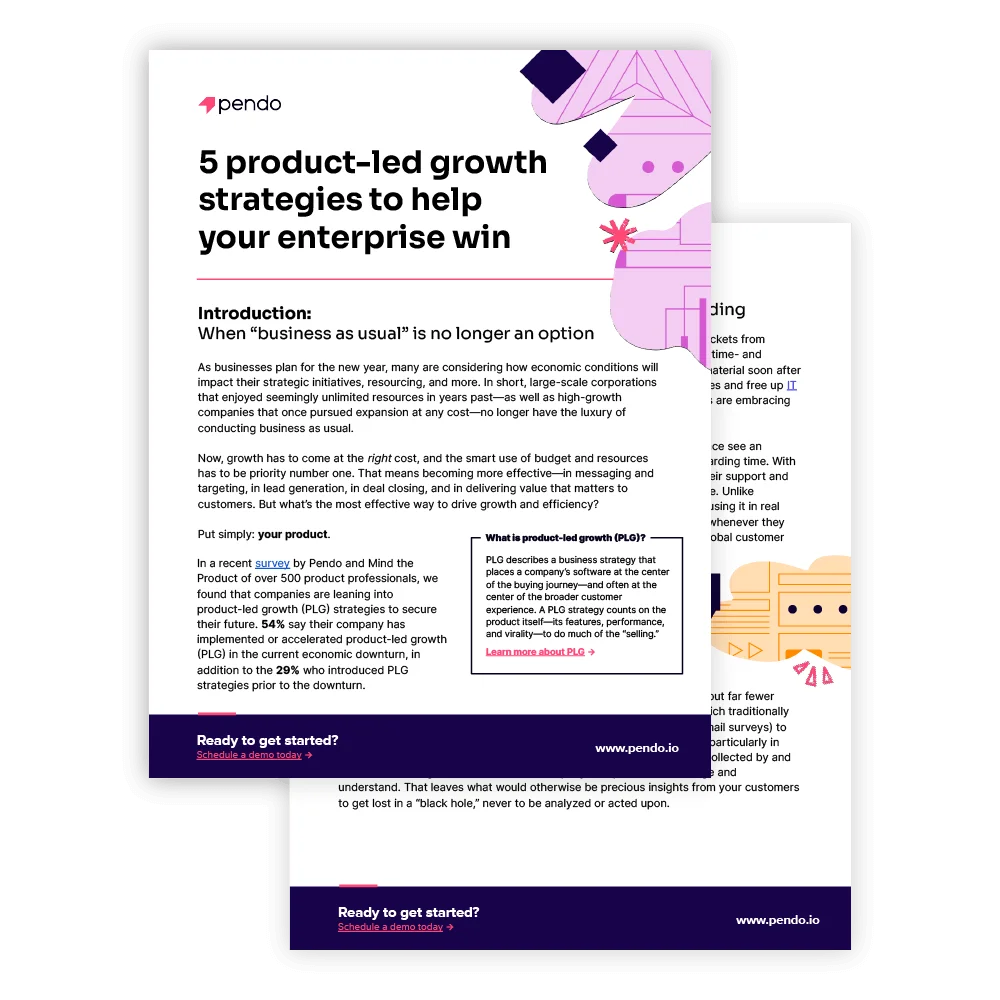
目次
In a rush? Download the PDF for later
Download the ホワイトペーパーはじめに
「平常運転」では通用しなくなるとき
As businesses plan for the new year, many are considering how economic conditions will impact their strategic initiatives, resourcing, and more. In short, large-scale corporations that enjoyed seemingly unlimited resources in years past—as well as high-growth companies that once pursued expansion at any cost—no longer have the luxury of conducting business as usual.
現在、成長のためにかけるコストは適正でなければならず、また予算とリソースの効率的な使用が何より優先されます。これは、メッセージの発信やターゲティング、リード生成、商談の成立、そして顧客への価値提供をさらに効果的に行うことを意味します。では、成長と効率化を推進するために最も効果的な方法は何でしょうか?
Put simply: your product.
In a recent survey by Pendo and Mind the Product of over 500 product professionals, we found that companies are leaning into product-led growth (PLG) strategies to secure their future. 54% say their company has implemented or accelerated product-led growth (PLG) in the current economic downturn, in addition to the 29% who introduced PLG strategies prior to the downturn.
大部分が自動化されていることからもその理由がわかります。予算が厳しくなり、採用が停止または縮小されている現在、今のままでよいという選択肢はもうありません。プロダクト自体を営業活動やマーケティング活動に活用することで、高価な広告キャンペーン、時間や人手がかかるアウトリーチ、およびその他の運用経費に費やされる貴重なリソースを節約できます。
But there’s another element to why businesses are turning to their products for better growth and efficiency: The data their products hold about customers and users. This is why, when asked about which trends would shape how their organization approaches product management in the future, 61% of organizations chose “new business decisions now made possible by product data” as an answer.
不況が差し迫った中で企業が成功を収めるために実施している5つのPLG戦略と、それぞれの戦略でデータが果たす役割を詳しく見てみましょう。
1. リテンション
使用状況のインサイトにより解約を事前に防止
Businesses achieve growth not just by continuing to gain new customers, but by retaining those they already have. In other words, a low churn rate is a pillar of a successful growth model—and at enterprise scale, can equate to millions of dollars saved. Low churn and high retention is also a core driver of greater efficiency. In almost every case, acquiring new customers costs more money, time, and resources than retaining existing ones. And the best way to drive retention is to ensure customers are continually deriving the maximum possible value from your product.
The most-forward thinking enterprise and large-scale organizations are leveraging the power of product analytics to examine customer usage data and identify at-risk accounts across their product portfolio. If a given account’s usage is significantly down period over period, if they haven’t adopted any new features, if users seem to be dropping off at key points in their workflows—any number of signs could indicate potential trouble.
The good news is that product teams have it in their power to flag these and other potential issues to their colleagues in customer success, who can then proactively reach out to the account to check in or help remedy any issues that might be arising. They can also target these accounts with customized, automated in-app support. Pendo has found that companies that leverage their products for this kind of proactive and scalable outreach see a 5% reduction in customer churn, as well as a 15% increase in net revenue retention (NRR).
2. 拡大
アプリ内でクロスセルとアップセルの機会を推進
Product analytics not only lets companies keep a finger on the pulse of customer health—it also arms businesses with insights that help them target the right accounts, for the right expansion opportunities, at the right time. And the companies that are leveraging their products to do this at scale are gaining efficiencies through automation.
アップセルの例を考えてみましょう。企業は自社プロダクトのフリーミアム版をユーザーに提供する場合があります。このバージョンでは、効果はすぐに得られるものの、使用できる機能やユーザー数は制限されます。フリーミアムの顧客がフリーミアム版の制限に達すると、企業は通知を送信して、有料版のサインアップを迅速かつスムーズにできるように促します。プロダクトに複数の有料バージョンがある場合、企業は、使用時の行動などに基づいて、提案や広告を顧客に合わせて調整できます。
This approach yields real results for businesses, while making the upgrade experience seamless for customers. Citrix, for example, was able to increase trial conversions by 28% using targeted messaging based on user data from Pendo.
Pendo has found that companies that invest in product-led strategies see a 5% reduction in customer churn and a 15% increase in net revenue retention (NRR), on average.
3. カスタマーサクセス
サポートとオンボーディングの効率的な拡大と自動化
IT部門の時間とリソースの大きな浪費として挙げられるのが、顧客からの問い合わせです。同様に、従来の新規ユーザーのオンボーディング手法も非常に時間と人手がかかる場合が多く、新しい顧客は長く、時に退屈なトレーニングが終わるとすぐに、その内容の多くを忘れてしまいます。この両方の問題に対処し、IT部門と顧客がより高い戦略的優先事項に集中できるようにするために、プロダクト主導型の企業はアプリ内通知を活用するプロダクト主導の戦術を採用しています。
Companies that leverage in-app messaging to deliver contextual guidance see an average 15% reduction in support tickets and a 27% reduction in onboarding time. With in-app guides and walkthroughs, companies can easily scale to keep their support and onboarding “supply” in line with the demand of a growing customer base. Unlike traditional training, these guides walk users through the app as they’re using it in real time to set them up for success. Plus, they’re always available to users whenever they need them—which is particularly valuable for large enterprises with a global customer and employee base using the product around the clock.
4. フィードバック
包括的なフィードバック管理システムの構築
多くの企業が「フィードバックする文化」の育成について話していますが、実際にその道を歩む企業は残念ながら少ないものです。どの組織でも、フィードバック収集は複数のチャネル(電話、Zoom、メールアンケートなど)でこれまでも行ってきましたが、まとまりがなく、不規則で、戦略的に行われているとは言えません。エンタープライズ企業や、複数のプロダクトを扱う大規模な組織の場合は特に、各部門で収集したフィードバックを管理したり理解したりすることがますます難しくなります。その場合、顧客から得た貴重なインサイトが「ブラックホール」に吸い込まれて消えてしまい、分析や対処ができなくなります。
Product-led companies see feedback as an invaluable resource to help answer all sorts of important questions—about what’s working in their product, what could be improved upon, and how to better serve their customers in a more efficient way. To gain the insights to deliver more value (and faster), they’re collecting feedback via polls and surveys from users where and when it matters most: in the app itself. They’re also managing that feedback in a single, centralized location that allows them to correlate product analytics to user sentiment data—making it easier and more efficient to turn insights from feedback into action.
For example, the team at Okta was able to increase the amount of feedback they collected by over 50% quarter over quarter, and use those insights to help boost feature adoption and drive user retention.
5. 優先順位付け
データを基盤とした、脱線しないロードマップの作成
プロダクトデータからは、今すぐ何を修正すべきかだけでなく、今後何を作るべきかもわかります。プロダクトデータを活用してロードマップを決定することで、どんなチームでも効率を高めることができます。しかし、企業の規模が大きいほど、価値を最大限に高め、期限内かつ予算内で、顧客の実際の要望と一致するプロダクトや機能を提供するためには、プロダクト開発やエンジニアリングに伴う無駄や労力を削減することが必要不可欠となります。
Too often, product and engineering teams still execute based on “gut feel”—prioritizing products and features in ways that don’t take behavioral or usage data into account. But this approach is detrimental: Pendo found that up to 80% of product features are rarely or never used. That means unnecessary spending, wasted time and resources, and no ROI to show for new features—all dangerous territory, particularly for publicly-traded companies or organizations with many stakeholders to stay accountable to.
計画を立てるためのより良い方法があります。それは、ユーザーの要望とニーズを十分に把握することから始まります。利用状況分析からの定量的データと、顧客からの定性的フィードバックを結び付けることにより、何が最も利用されているか、ユーザーが何を最も必要としているか、ユーザーがプロダクト体験についてどのように考えているかを知ることができ、より良いプロダクトを、より速く、より効率的に開発することが可能になります。
おわりに
プロダクトを通じて組織の将来性を確固たるものにする
顧客や見込み客に関するデータ(課題、機能リクエスト、ビジネス上の希望など)が多ければ多いほど、現在のプロダクト、そして将来開発するプロダクトを顧客や見込み客に合わせて調整し、顧客が本当に必要とするプロダクトを提供できます。これにより、顧客を成功に導くことができるのです。このように体験をカスタマイズすることで、プロダクトがビジネスを加速、そして効率化できるのです。
For even more resources and insights on how to bring a product-led approach to your organization, visit our Product-led Hub.
